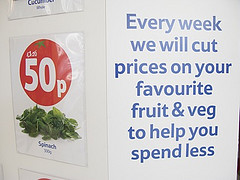A quick quiz before we get to the questions you need to be asking yourself about promotions.
need to be asking yourself about promotions.
Question 1: Which activity takes up the most time for marketing, trade marketing and sales teams?
Answer: Managing promotions (a bonus point for anyone who said “sitting in pointless meetings” 🙂
Question 2: Seventy percent of what type of activity loses money for manufacturers?
Answer: Promotions……. again!
We, as marketers, trade marketers and sales teams spend most of our time doing activities which simply don’t make money! Worse still, many companies don’t even evaluate all of their promotional activities, despite their suspicions that they probably aren’t delivering any meaningful return.
I was prompted to write this by a comment on my last blog. The comment basically supported the idea that people should spend more time in stores, but that in these days of shrunken overheads, teams were already under pressure and simply didn’t have the time.
Management thinking dictates that when prioritizing what to do, the lowest value tasks get de-prioritized. And that got me thinking about promotions.
Now before you say it, I know that promotions have to be done – they are a “necessary evil” in many ways. Pressure to hit sales targets, pressure from retailers for support – there are lots of reasons which keep us promoting. And great promotions can add value. A “winning promotion” creates new consumption habits which fuel long term growth, as well as delivering financial returns to retailer and manufacturer. But how many promotions actually fall into that category?
Think about the true cost of promotion. If 70% lose money based on the simplest calculation on return on investment (see above), many more lose money when the total costs are included. Here’s a few of the hidden costs of promotion, that I know are not always included in promotion evaluations (if these evaluations are even done at all).
The cost of time: From surveys of our clients, engage estimates that up to 60% of a trade marketing team’s time; 50% of a Key Account Managers time; 15% of a brand managers time (plus the time of their bosses)
The opportunity cost: What could those people have being doing to add value if they weren’t managing promotions?
Production costs: Most evaluations include the cost of production, but do they include the cost of overtime to manage the build-up of stocks necessary for promotions, or the downtime on the factory floor after the promotion? These costs may be one-off, or they may increase the average cost of production in such a way as to inflate next year’s prime cost.
Higher Inventory: Somewhere in the chain there is much more product – and that reduces returns for someone.
Logisitics: Extra trucks and storage for the manufacturer and the retailer.
Disappointed Shoppers: In a series of store visits we carried out over 90% of out-of-stock products were on promotion. Kantar has recently quoted 12% out of stocks for walmart.com. It is simply harder to forecast sales whilst promoting, so promotions risk either much higher inventory or out-of-stocks. Out-of-stocks are the biggest frustration for shoppers, and the best way to encourage shoppers to try your competitor. How many loyal shoppers who would have paid full price for the product aren’t able to because someone else has bought five packs on a deal? And we pay for the privilege!
Loading shoppers: This is often built into evaluations, but it’s worth mentioning anyway. If shoppers buy more on deal, unless they consume more too, then the pantry is loaded, and they won’t buy for a period of time afterwards.
Training Shoppers: Shoppers get used to discounts, and expect them.
I read a blog recently which asked whether, as shoppers are (if you believe the hype) looking for more engagement in this new world of mobile, BOGOFS might disappear from shelves. Unfortunately this is still a pipe dream, at least until manufacturers and retailers wean themselves off this unhealthy addiction.
Going cold turkey on promotions might be just a little too painful, but by considering the following questions before diving in, perhaps we may be in a position to take the first steps away from discount madness:
- Does the promotion change shopping behavior in a way which will encourage or drive additional consumption? If yes, then at least we aren’t loading
- Does it encourage long term changes in consumption? If yes, then this activity may have some real strategic value?
- Is there a clear understanding of the total costs of the promotion? If not, we may be deluding ourselves about the financial returns being made.
- Is there a clear understanding of return on investment for the manufacturer?
- Is there a clear understanding of the return on investment for the retailer?
So if you are short of time, wish you were able to do higher value tasks (even getting out to stores) or are concerned about the amount of time or expense that is being wasted on promotions, just think through this list of questions and aim to do a little less of the worst type of promotions.



